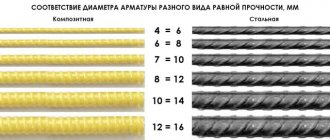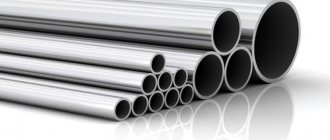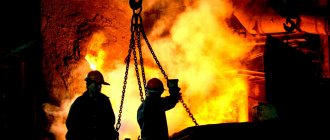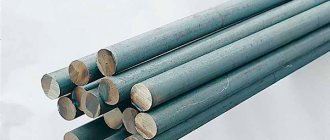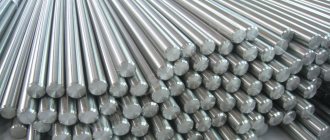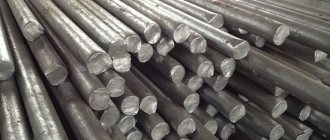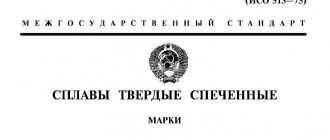Normative documents
GOST 82-70. Rolled hot-rolled broadband universal steel. Steel 40X.
GOST 103-76. Hot-rolled steel strip. Assortment. Steel 40X.
GOST 1051-73. Calibrated rolled products. General technical conditions. Steel 40X.
GOST 1133-71. Forged steel round and square. Assortment. Steel 40X.
GOST 1577-93 Rolled thick sheets and wide sheets of structural quality steel. Technical conditions. Steel 40X.
GOST 2590-88. Hot-rolled round steel. Assortment. Steel 40X.
GOST 2591-88. Hot-rolled square steel. Assortment. Steel 40X.
GOST 2879-88. Hot-rolled hexagonal steel. Assortment. Steel 40X.
GOST 7417-75. Calibrated round steel. Assortment. Steel 40X.
GOST 8479-70. Forgings made of structural carbon and alloy steel. General technical conditions. Steel 40X.
GOST 8559-57. Calibrated square steel. Assortment. Steel 40X.
GOST 8560-78. Calibrated hexagonal rolled products. Assortment. Steel 40X.
GOST 10702-78. Rolled products from high-quality structural carbon and alloy steel for cold extrusion and upsetting. Technical conditions. Steel 40X.
GOST 13663-86. Profile steel pipes. Technical requirements. Steel 40X.
GOST 19903-74. Hot rolled sheet products. Assortment. Steel 40X.
GOST 4543-71
When producing steel, manufacturers are guided by GOST 4543-71 standards. It defines the technical conditions for rolled alloy structural steel. Its standards apply to such types of rolled products as ingots, forgings, etc.
GOST 4543-71 gives a clear classification of structural alloy steels. In accordance with it, steel grade 40X belongs to the group of chromium steels.
The same document defines quality parameters, that is, it determines the maximum permissible amount of impurities that affect the technical characteristics of structural alloy steel. Such impurities include sulfur, phosphorus, copper and some others.
By the way, the same document defines the heat treatment regimes for rolled products.
Mass fraction of steel elements 40Х according to GOST 4543-2016
| C (Carbon) | Si (Silicon) | Mn (Manganese) | P (Phosphorus) | S (Sulphur) | Cr (Chrome) | Mo (Molybdenum) | Ni (Nickel) | V (Vanadium) | Ti (Titanium) | Cu (Copper) | N (Nitrogen) | W (Tungsten) | Fe (Iron) |
| 0,36 — 0,44 | 0,17 — 0,37 | 0,5 — 0,8 | < 0,04 | < 0,04 | 0,8 — 1,1 | < 0,11 | < 0,3 | < 0,05 | < 0,03 | < 0,3 | < 0,012 | < 0,2 | rest |
CE = C + Mn/6 + (Cr + Mo +V)/5 + (Ni + Cu)/15. The chemical composition can be changed by agreement. Em = 0.3Cr + 0.5Ni + 0.7Cu. For case-hardened steels, Al > 0.02 is allowed. The content of P may be changed by agreement. As agreed: Ca < 0.003.
Given the complexity of producing this steel, the exact percentage of carbon content is not determined, but ranges from 0.36% to 0.44%. The main alloying additive is chromium, from 0.8% to 1.1%. It is this element that forms the main characteristics of the alloy. Despite the fact that the content of nickel, manganese and silicon is small - up to 1.0%, they affect the properties of steel during the operation of products made from it.
A small copper content (up to 0.035%) does not have a significant effect on the characteristics. The concentration of harmful additives (sulfur, phosphorus) is under strict control.
Decoding steel 40X
Grade 40X is classified as structural, alloyed. As a result of the fact that the steel can contain from 0.36 and 0.44% carbon and from 0.8 to 1.1% chromium, it becomes difficult to weld. That is, to obtain a high-quality seam it is necessary to perform a number of additional technological operations. Before welding begins, the edges of the parts must be heated to 300 ºC. After the seam is obtained, annealing must be performed.
Full composition of 40X:
| C(carbon) | Si(silicon) | Mn(manganese) | Ni(nickel) | S(sulfur) | P(phosphorus) | Cr(chrome) | Cu(copper) |
| 0,36-0,44 | 0,17-0,37 | 0,5-0,8 | up to 0.3 | up to 0.035 | up to 0.035 | 0,8-1,1 | up to 0.3 |
The chemical composition of 40X steel allows it to be used for the production of parts with high strength parameters. These details include:
- mechanism shafts;
- axles;
- spindles;
- gear rings, etc.
Chemical composition
Throughout the CIS, the characteristics and use of 40X steel are determined by GOST 4543-2016. It indicates the chemical composition and basic performance properties. Decoding the steel indicates the content of the main components - carbon and chromium.
The first two characters indicate the concentration of the main alloying element - carbon, it is in the range of 0.36-0.40%. It is difficult to maintain a more precise concentration during the metal smelting process.
The letter "X" indicates the presence of chromium, which improves the corrosion resistance of the material. However, its concentration does not exceed 0.8-1.1% and is insufficient to impart sufficient corrosion resistance to steel.
The alloy also contains other alloying additives that are not indicated in the markings, but impart certain properties to 40X steel:
- nickel – up to 0.3%;
- manganese – 0.5-0.8%;
- silicon – 0.17-0.37%;
- copper is present in very small quantities, about 0.035%, and does not significantly affect the mechanical properties of the alloy;
- The concentrations of harmful impurities - sulfur and phosphorus - are strictly regulated; their content does not exceed 0.035%.
Advantages and disadvantages
The pros and cons of a material are determined by its properties. Among the characteristics of 40X steel, hardness and endurance are of particular importance. Due to the presence of chromium in the alloy, parts made from it:
- have a high margin of strength and corrosion resistance;
- designed for high and long-term loads;
- resistant to extreme temperatures in the range from -40 to +425 degrees;
- withstand sudden temperature changes; the magnetic properties of 40X steel do not affect its performance characteristics;
- can be used in almost any external conditions;
- do not require cleaning or surface treatment;
- have a high limit of endurance and resistance to warping.
After hardening, the carbide contained in the alloy is completely dissolved, and the metal acquires higher corrosion resistance.
The chemical properties of 40X steel allow it to be used in aggressive wet environments. The material also lends itself well to cutting operations. In terms of weldability, the alloy belongs to group 4.
To avoid cracks in the welding seam, it should be preheated to 200-300 degrees.
Disadvantages of steel include temper brittleness and flake sensitivity, however, heat treatment technologies make it possible to reduce these properties to minimal values.
Application
Due to low heat resistance and hardness, 40X is not used as hunting or household knives. However, it is widely used in the manufacture of throwing knives and darts. Since this type of tool is characterized by a special form of sharpening of the edge, the high strength of the material and its ability to withstand impact loads are important. In addition, it is easily polished, so products can be quickly restored to their previous condition.
Russian industrial enterprises use this steel to produce shafts, axles, gears and gears, and other products for similar purposes.
Characteristics
The characteristics of 40x steel include:
- hardness;
- density;
- yield/strength strength;
- impact strength, etc.
Critical point temperature
| Critical point | °C |
| Ac1 | 743 |
| Ac3 | 815 |
| Ar3 | 730 |
| Ar1 | 693 |
| Mn | 325 |
Hardness
Steel hardness (hb - hrc) can be expressed in different numerical values, depending on the measurement scale:
- According to Rockwell, the technique is based on measuring the depth of penetration of an indenter (hard tip) into the material under study. The hardness on this scale is 217 MPa.
- According to Brinell, the indenter is pressed into a metal sample for 2-8 seconds (the load is gradually increasing) and the diameter of the resulting indent is measured. Balls made of durable alloys with a diameter of 1 to 10 mm are used as indenters. The Brinell hardness of steel 40x is 187 MPa.
- In the melting state, the hardness during the melting period fluctuates within 18 MPa.
Note! The harder the steel, the less strength it has. In the first case, it is impossible (or difficult) to scratch it with anything, in the second, it can be damaged even from a light blow (this is insufficient strength).
Density
The density of steel 40x is 7820 kg/m³. The density of a substance is a constant value, and is measured using the hydrostatic method - a sample is weighed in air and then in water, and its density (the ratio of body mass to volume) is calculated. The liquid used as a measurement must wet the material well, but not react with it. Therefore, distilled water is used for weighing.
Brand
This grade implies a steel content of 0.40% carbon and about 1.5% chromium.
Possible substitutes are 45Х, 38ХА, 40ХС, etc. Class: structural alloy. Type and condition of delivery:
- long products (including shaped);
- rod and silver;
- the leaf is thick;
- pipes, etc.
The term “structural” indicates that metal is used for the manufacture of various structures, mechanisms and parts, for example, in the field of construction and mechanical engineering.
Tensile strength
The tensile strength is understood as the mechanical stress above which the material is destroyed or deformed. The maximum strength of steel at the moment of bending is 509 MPa, and at temporary resistance - 960 MPa.
This indicator is measured using tensile and deformation tests. In this case, not only the tensile strength is determined, but also elongation, temporary resistance, etc.
Weldability
| No limits | Limited | Difficult to weld | |
| Heating | No | up to 100–1200С | 200–3000С |
| Heat treatment | No | There is | annealing |
Yield strength
The physical yield strength is the stress value at which the deformation of the material under test increases without additional load. The yield strength of steel 40x is 785 N/mm2. The final result is influenced by various factors:
- metal thickness;
- heat treatment mode;
- the presence of impurities in the product;
- crystal lattice defects, etc.
Strength
Strength is the resistance of a metal to external loads. To find out what the strength of steel is, tests are carried out on special machines with different power levels. The latter consist of a loading mechanism that creates force, and are either mechanical or hydraulic.
Steel 40x has high strength - 271 MPa. It is also able to maintain structure under heavy loads.
Tendency to temper brittleness
Prone.
Endurance limit
| σ-1, MPA | J-1, mPa | n | Steel condition |
| 363 | 240 | 106 | σв=690 MPa |
| 470 | 106 | σв=690 MPa | |
| 509 | 5*106 | σ0.2=690 MPa, σв=690 MPa | |
| 333 | σв=690 MPa | ||
| 372 | Quenching 860 °C, oil, tempering 550 °C |
Impact strength
The impact strength of this brand is 400 – 850 kJ/sq. m. Tensile strength is 980 N/m2. Impact toughness refers to the ability of a metal to absorb mechanical energy generated during the process of destruction and deformation.
Hardenability of steel according to GOST 4543-71
| Distance from the end, mm | Note | |||||||||
| 1,5 | 4,5 | 6 | 7,5 | 10,5 | 13,5 | 16,5 | 19,5 | 24 | 30 | Hardening 860 °C |
| 20,5-60,5 | 48-59 | 45-57,5 | 39,5-57 | 35-53,5 | 31,5-50,5 | 28,5-46 | 27-42,5 | 24,5-39,5 | 22-37,5 | Hardness for hardenability strips, HRC |
Forging
| Type of semi-finished product | t, 0С | Cooling | |
| Section size | Conditions | ||
| mm | |||
| Ingot | 1250–800 | ||
| Blank | up to 350 | On air | |
cutting
| Initial data | Machinability Ku | |||
| State | HB, MPa | sB, MPa | hard alloy | high speed steel |
| hot rolled | 163–168 | 620 | 1,2 | 0,95 |
Welding
| Weldability | Welding methods | Recommendations |
| Difficult to weld | ESH, RDS, KTS | Heating + heat treatment |
Flock sensitivity
Sensitive.
Melting point of steel 40x13 and decoding of the brand
Stainless steel 40X13 is one of the modern products of metallurgy. It was developed as a new material with unique properties.
One of its characteristic features is the difficulty of heat treatment, however, it is this procedure that helps improve the qualities of the metal
.
Technical characteristics are not determined by a carefully adjusted ratio of components, but by hardening and other methods of processing the material with temperature
. The softness of 40Х13 steel does not make it impossible to sharpen, so it is used in industry and everyday life.
Cold rolling is practically not carried out.
Processing after plastic deformation is softened by annealing at a temperature of 750-800 degrees, as well as cooling in an oven and in air with a gradual decrease in temperature from 500 degrees to normal conditions.
After this, hardening is carried out at a temperature of 950-1000 degrees, followed by cooling in an oil bath or in air
. This ensures the hardness and anti-corrosion qualities of the material.
Return
Decoding
Decoding steel 40X13 allows you to obtain basic information about the material:
- 40 – 0.4% carbon;
- X13 – 13% chromium.
Return
Chemical composition
In some cases, the name of the steel looks different: 4Х13. It refers to corrosion-resistant materials that can maintain their qualities when used at elevated temperatures.
.
An alternative metal produced in Russia is 30X13 with a reduced amount of carbon
. The composition of steel 40Х13 includes:
- carbon in the amount of 0.4%;
- chromium – 13%;
- impurities and auxiliary elements – up to 0.8%.
From this material you can make:
- spring mechanisms, fasteners, bearing shafts;
- parts for work when exposed to aggressive substances and at t
- instruments used in medicine;
- cutting parts;
- measuring instruments.
For the production of stainless steel 40X13, induction furnaces are used; the melting of the composition is carried out at t = 1500-1600 C. This guarantees the deformation of the components and their connection with each other.
To eliminate steel defects, various types and temperatures of processing are used
.
The maximum effect from using metal in difficult working conditions is observed when grinding the surface.
The restriction on the manufacture of parts applies only to those structures that will be welded in the future.
Return
Properties
Steel 40X13 is characterized by manufacturability during hot plastic deformation, and the temperature should be in the range of 850-1100 degrees. Failure to comply with processing rules can lead to the loss of some of the metal's features and characteristics, for example, hardness
.
To eliminate this risk, a low heating rate is provided
.
The temperature of 830 degrees allows rolling or forging
. Cooling should also occur slowly.
Cold deformation can lead to a violation of the integrity of the material and the appearance of a number of other defects, so it is practically not used.
The characteristics of 40X13 stainless steel are similar to carbon steel, however, the different microstructure causes the increased complexity of processing the first type of metal. When milling and sharpening, the main problems are:
- low wear resistance of the material;
- removal of processing waste;
- hardening due to cutting.
Machining involves the formation of spiral-shaped chips. This requires the use of chipbreakers into which the cutting tool is mounted.
The low thermal conductivity of steel grade 40Х13 is an advantage during operation, and during sharpening it causes an increase in labor costs. During processing, a local increase in temperature occurs, which leads to the development of work hardening and hardening
. As a result, the durability of the product is reduced and subsequent processing becomes more difficult.
Carbide and other compounds in the composition lead to an increase in grain size. When processing metal, the sharpening tool fails, which increases the processing time. To minimize such risks, a tool with a layer of tungsten carbide or a composition with similar properties is usually used.
Grade 40X13 is characterized by maximum resistance to corrosion after hardening at a temperature that ensures complete dissolution of carbides. When the tempering temperature increases, the opposite effect is observed, which is due to the formation of chromium carbides.
Corrosion resistance 30Х13 is higher than 4Х13
.
Tempering at 600 degrees causes a short-term decrease in corrosion resistance
.
However, this effect disappears with further release
.
At the same time, the anti-corrosion properties of steel in the hardened and low-tempered state remain higher.
The greatest efficiency from the use of the material is ensured by heat treatment by tempering at 200-400 degrees or 600-650 degrees. In the latter form, the metal belongs to the category of structural.
Return
Specifications
The primary characteristics of steel 40Х13 are presented:
| heat resistance | up to 600 degrees; |
| hardness according to HB | 143-229 MPa; |
| forging and melting temperature | 1500-1600 degrees; |
| specific gravity | 7680 kg/m3; |
| martensitic transformation | 270-80 degrees. |
No metal is used for welded structures.
Return
Price
The price of steel 40X13 is about 225 rubles. per kg. The final cost is determined based on the order volume.
Return
Application
The characteristics of the material make it possible to use it in aircraft construction. This is due to high strength, resistance to temperature changes, and low weight.
. The material is used to make engine parts, as well as to create individual parts of the fuselage.
Another name for steel is knife steel. If the material is soft, it is possible to increase its hardness to 57 HRC by heat treatment. Therefore, one of the areas of application of 40Х13 steel is the manufacture of knives
. They can be used at home, hunting, fishing, etc. This is due to the lack of corrosion on the product, as well as ease of maintenance.
Return
Assortment
The main rolled elements are produced:
- sheet material (Gosstandart 5582-75),
- rod (Gosstandart 18907-73),
- wire (State Standard 18143-72).
Return
Heat treatment
The composition of the metal after hardening includes austenites, martensites, and carbides. At t > 2022 C, hardness decreases significantly, which is due to the material approaching the austenitic state
. At t
Heat treatment of steel 40Х13 has its own characteristics, which guarantee the acquisition of basic technical qualities, incl. resistance to corrosion.
The last stage is hardening at t = 950-1000 degrees and cooling in an oil bath or in air
.
When the processing requirements and sequence of operations are met, an increase in hardness and anti-corrosion properties is guaranteed.
Return
Metal melting point
Steel 40×13 belongs to chromium stainless metals. Its main operational properties are determined by its special chemical composition.
Melting point is a physical characteristic that determines the temperature at which a metal transitions from solid to liquid
.
When the amorphous state changes, the material practically does not change its volume, that is, atmospheric pressure does not affect the process of restructuring the crystal lattice.
The physical indicator under consideration largely depends on the chemical composition. Some elements can lower or increase their melting point
.
Steel 40x13 (GOST also defines an insignificant concentration of impurities that are not reflected in the marking) has a fairly high concentration of alloying elements, which provide high corrosion resistance
. The brand is deciphered as follows:
- A fairly high carbon concentration (from 0.36 to 0.45%) determines the high surface hardness.
- Anti-corrosion qualities are ensured by a chromium concentration of 12-14%.
- The composition contains no more than one percent of manganese and silicon, as well as some harmful impurities.
Steel 40x13, the characteristics of which have determined its use in a wide variety of industries, can be operated at temperatures up to 500 degrees Celsius. In addition, 40x13, heat treatment of this brand allows you to improve the basic qualities; it belongs to the class of medium-melting materials.
Steel classification
The melting point of metals can vary over a fairly wide range. Some require special equipment to melt, others can be converted into a liquid substance using a regular furnace
. The classification of steel by melting point is as follows:
- Low-melting - melting temperature reaches 600 degrees Celsius. This group may include tin, zinc or bismuth
. Such materials can be easily melted without the use of special equipment. - Medium-melting - a change in the state of the material occurs at temperatures from 600 to 2022 degrees Celsius. This group includes copper, tin, aluminum or iron
. This group is the most widespread. It can also include some stainless steels, for example, 40x or other alloys with a small concentration of chromium, as well as 55 structural steel or analogs. - Refractory - a change of state occurs at more than 2019 degrees Celsius. As a rule, this group includes metals that contain impurities of chromium, tungsten or titanium in high concentrations. An example is the marking x40 or x30сrх13, 4х13
.
Large amounts of chromium are added to metals to protect them from exposure to high humidity or certain chemicals
.
That is why stainless steels, which have high anti-corrosion properties, have high refractoriness
. This group includes metals called medicinal.
An interesting point is that the only metal that is in a liquid state at ordinary ambient temperatures is mercury. This is due to the fact that it turns into liquid already at a temperature of -39 degrees Celsius.
Application area
The melting point largely determines at what heating the metal begins to lose its basic properties: hardness (hrc), ductility and others.
Steel 40x, the characteristics of which can be found in many methodological descriptions, begins to become more plastic when heated to 350 degrees Celsius.
This does not allow the use of this metal, 13x or other analogues when creating products that are used in difficult conditions.
Recently, metals that have received the aisi marking have become quite widespread. These materials are improved versions of conventional stainless steel: greater corrosion resistance, hardness and other qualities
. Due to heat treatment, the structure of the material changes.
Today, a huge number of different metals and alloys are produced that have unique performance properties. An example is the metals s290 and xv6.
As a rule, the scope of application is limited by the cost of production of the material, since no one uses expensive metal for the manufacture of non-critical parts
.
For example, s290 can be used to make a knife, but the alloy will significantly increase the final cost of the product.
Reviews about steel
Brand 40x13 has good qualities, I used it in the form of sheet metal for covering the working part of a woodworking machine
Victor
The malleability of 40x13 is very low; this material cannot be processed at home
Michael
Steel 40x13 is very good in that even after long-term use, corrosion does not appear on the surface
Alexei
Heat treatment of steel 40Х
One of the key characteristics of metal is hardness, that is, the ability to resist the penetration of other, harder materials into it. The level of hardness determines the possibility of using metal in the production of certain machine parts and mechanisms.
The hardness of the metal has a direct impact on:
- Strength;
- Resistance to wear and a number of others.
A process engineer, when selecting metal processing modes from 40X steel, is guided, among other things, by hardness parameters. To change the hardness parameter, heat treatment is used.
In addition, it is necessary to improve the mechanical properties of both individual parts and the structure as a whole. As delivered, the hardness of 40X steel is 217 MPa - according to Brinell. To increase it, various heat treatment methods are used.
In particular, for 40X the following hardening methods are used:
- single refrigerant;
- two refrigerants;
- coolant jets;
The first method implies that one type of coolant will be used (water, oil, etc.).
The second assumes that after cooling the workpiece in water, it is sent to oil.
The third method is based on directing a jet of coolant (oil, water) onto the heated part of the part. This method is used if there is a need to harden a certain part of a part, for example, the crown of a gear wheel. In addition, this technology is distinguished by the fact that during the processing there is no “steam” jacket and this has a positive effect on the quality of hardening.
During the heat treatment process, problems arise in protecting the part from defects that may appear after scale has appeared (a consequence of exposure to oxygen) or carbon burnout. To prevent this, the chamber in which the workpiece is heated is saturated with gas, which is a product of methane combustion. In fact, protecting the workpiece from exposure to atmospheric oxygen is an important task.
By the way, heat treatment of products made of 40X steel is best carried out in a hermetically sealed oven. Sometimes, cast iron shavings are used to isolate a part from the influence of foreign factors during processing in a furnace. That is, the workpiece is covered with cast iron shavings or crumbs.
Selecting a coating for a stainless steel part
You're damn smart. It's actually an acronym.
I take my hat off to the experienced specialist. I didn’t expect that such a designation for stainless steel would confuse anyone. In the area where I work it is generally accepted.
As far as I understand, no one knows about the coverage. As they said in one old program, “the money goes to the viewer, the experts lose.” There is information that it is necessary to coat Ts9 Chem.Phos.prm.
Offtop: The 90-9-1 rule of thumb, somewhat similar to the Pareto Rule (20/80), describes the ratio between the number of people who will participate in a community, comment and simply read. According to it, 1% or less of people will create new content, 9% will edit or comment on it, and 90% will just silently read it without any participation. The rule also states that for every active participant in an online forum, 99 people will simply read his message.
Is it true? Of course, the exact ratio will vary, for example, as Aqil Awan's research on the radical jihadist forum showed, 87% of users wrote nothing, 13% wrote at least once, 5% wrote 50 or more messages, and only 1% left more than 500 messages. But even with an invitation system and closed registration, creators will still be in the minority. This conclusion was reached by Michael Wu, who analyzed the unevenness of participation in hundreds of communities divided by field of activity and type of audience.
Source
Alloy properties
The physical and mechanical properties of 40X steel allow it to withstand high loads without destroying its structure:
- density – 7820 kg/m3; elastic modulus – 2.14Х10-5;
- coefficient of linear expansion – 11.9Х106 1/deg.;
- electrical resistivity – 210Х109 Ohm*m;
- impact strength – 160 J/cm2;
- forging temperature – from 1250 to 800 degrees.
Almost all indicators change depending on temperature. As it increases, the following increases:
- resistivity;
- linear expansion coefficient;
- specific heat.
The inverse dependence on temperature is demonstrated by:
- elastic modulus;
- metal density;
- coefficient of thermal conductivity.
An important characteristic is the yield strength indicator. It is determined by the magnitude of the load at which irreversible deformations occur in the product. The indicator depends on several factors: heat treatment mode; type of alloying additives and amount of harmful impurities; crystal lattice structure.
For steel 40X, the yield strength decreases in the temperature range of 100-500 degrees from 490 to 345 MPa. Tempering brittleness and flake sensitivity have a negative impact on the quality of the alloy. Steel is difficult to weld and requires preheating and subsequent heat treatment.
Physical and mechanical properties
When considering the mechanical properties of 40X steel, it should be taken into account that it has high hardness and strength, the structure can withstand significant loads and is not subject to destruction during operation. Steel 40X is characterized by the following positive qualities:
- Quite high corrosion resistance, which is achieved by including chromium in the composition.
- High strength indicators. Hardness is measured in various indices, HRC and HB are often used. The hardness indicator corresponds to a value of 217 MPa.
- When choosing a more suitable material, attention is paid to specific gravity. The density of 40X steel is 7820 kg/m3.
The elastic modulus and yield strength can vary over a fairly wide range, depending on temperature. For example, with a significant increase in temperature, the elastic modulus decreases. The yield strength determines how applicable the alloy is when producing workpieces by casting.
The alloy also has several significant disadvantages:
- Tempering fragility. After hardening, the structure becomes very susceptible to impact loads. The likelihood of increased brittleness can be reduced by following heat treatment technology.
- High tendency to form flakes. It is characteristic of quite a large number of different alloys.
- Poor weldability complicates the manufacturing process of various products. If desired, a variety of welding technologies can be used. The process is greatly simplified by preheating the structure. In addition, the structure is difficult to cut when using welding equipment.
- Flock sensitivity is a property that determines the high probability of internal cracks appearing after casting various products. Such defects often occur during hot deformation of alloy steel. Such defects cause high concentrations of hydrogen during heat treatment. The likelihood of defects can be reduced by strictly observing the temperature regime.
Recently, the method of vacuumization of the alloy has been quite often used, due to which the hydrogen concentration is reduced. That is why the quality of the resulting structure increases significantly.
Heat treatment
| Heat treatment modes | ||||||||
| 1 option | Wednesday | t, 0С | Option 2 | Wednesday | t, 0С | Option 3 | Cooling medium | t, 0С |
| Annealing | with oven | 820–840 | Normalization | air | 850–870 | Hardening | oil/water | 840–875 |
| Vacation | 560–650 | Vacation | air/ water/ oil/ oven | 450–650 | ||||
Brand of steel and alloys
Types of supply of material 40Х
| B03 - Metal forming. Forgings | GOST 8479-70; |
| B22 – Long and shaped rolled products | GOST 9234-74; GOST 1133-71; GOST 11474-76; GOST 2879-2006; GOST 2591-2006; GOST 2590-2006; |
| B23 - Sheets and strips | GOST 103-2006; GOST 19903-74; GOST 82-70; |
| B32 – Long and shaped rolled products | GOST 8560-78; GOST 8559-75; GOST 10702-78; GOST 7417-75; GOST 4543-71; GOST 1051-73; GOST 14955-77; |
| B33 - Sheets and strips | GOST 1577-93; |
| B62 — Steel pipes and connecting parts for them | GOST 24950-81; GOST 23270-89; GOST 7909-56; GOST 9567-75; GOST 8734-75; GOST 8733-74; GOST 8732-78; GOST 8731-87; GOST 53383-2009; |
| B71 – Low carbon steel wire | GOST 1526-81; |
Chemical composition in % of material 40Х
GOST 4543 - 71 C Si Mn Ni SP Cr Cu0.36 - 0.440.17 - 0.370.5 - 0.8 to 0.3 to 0.035 to 0.0350.8 - 1.1 to 0.3
The temperature of the critical points of the material is 40X.
Ac1 = 743, Ac3(Acm) = 782, Ar3(Arcm) = 730, Ar1 = 693
Technological properties of material 40Х.
| Weldability: | difficult to weld. |
| Flock Sensitivity: | sensitive. |
| Tendency to temper brittleness: | inclined. |
Mechanical properties at T=20oC of 40X material.
| Hardness 40X after annealing, GOST 4543-71 | HB 10 -1 = 217 MPa |
| Hardness 40X, Pipes GOST 8731-87 | HB 10 -1 = 269 MPa |
| Hardness 40X, Cold-deformed pipes. GOST 8733-74 | HB 10 -1 = 217 MPa |
| Hardness 40X, hot rolled rod. GOST 10702-78 | HB 10 -1 = 179 MPa |
Physical properties of material 40X.
| T | E 10- 5 | a 10 6 | l | r | C | R 10 9 |
| hail | MPa | 1/Grad | W/(m deg) | kg/m3 | J/(kg deg) | Ohm m |
| 20 | 2.14 | 7820 | 210 | |||
| 100 | 2.11 | 11.9 | 46 | 7800 | 466 | 285 |
| 200 | 2.06 | 12.5 | 42.7 | 7770 | 508 | 346 |
| 300 | 2.03 | 13.2 | 42.3 | 7740 | 529 | 425 |
| 400 | 1.85 | 13.8 | 38.5 | 7700 | 563 | 528 |
| 500 | 1.76 | 14.1 | 35.6 | 7670 | 592 | 642 |
| 600 | 1.64 | 14.4 | 31.9 | 7630 | 622 | 780 |
| 700 | 1.43 | 14.6 | 28.8 | 7590 | 634 | 936 |
| 800 | 1.32 | 26 | 7610 | 664 | 1100 | |
| 900 | 26.7 | 7560 | 1140 | |||
| 1000 | 28 | 7510 | 1170 | |||
| 1100 | 28.8 | 7470 | 120 | |||
| 1200 | 7430 | 1230 | ||||
| T | E 10- 5 | a 10 6 | l | r | C | R 10 9 |
Foreign analogues of material 40X
Attention! Both exact and closest analogues are indicated.
| USA | Germany | Japan | France | England | European Union | Italy | Belgium | Spain | China | Sweden | Bulgaria | Hungary | Poland | Romania | Czech | Australia | South Korea |
| — | DIN,WNr | JIS | AFNOR | B.S. | EN | UNI | NBN | UNE | G.B. | SS | BDS | MSZ | PN | STAS | CSN | AS | KS |
| 5135 | |||||||||||||||||
| 5140 | |||||||||||||||||
| 5140H | |||||||||||||||||
| 5140RH | |||||||||||||||||
| G51350 | |||||||||||||||||
| G51400 | |||||||||||||||||
| H51350 | |||||||||||||||||
| H51400 |
| 1.7035 |
| 1.7045 |
| 37Cr4 |
| 41Cr4 |
| 41CrS4 |
| 42Cr4 |
| SCr435H |
| SCr440 |
| SCr440H |
| 38C4 |
| 38C4FF |
| 41Cr4 |
| 42C4 |
| 42C4TS |
| 41Cr4 |
| 530A36 |
| 530A40 |
| 530H36 |
| 530H40 |
| 530M40 |
| 1.7035 |
| 1.7039 |
| 37Cr4 |
| 37Cr4KD |
| 41Cr4 |
| 41Cr4KD |
| 41CrS4 |
| 36CrMn5 |
| 37Cr4 |
| 38Cr4KB |
| 38CrMn4KB |
| 41Cr4 |
| 41Cr4KB |
| 38Cr4 |
| 38Cr4DF |
| 41Cr4 |
| 41Cr4DF |
| 42Cr4 |
| F.1201 |
| F.1202 |
| F.1210 |
| F.1211 |
| 38CrA |
| 40Cr |
| 40CrA |
| 40CrH |
| 45Cr |
| 45CrH |
| ML38CrA |
| ML40Cr |
| SCr435H |
| SCr440 |
| SCr440H |
| Mechanical properties : | |
| sв | — Short-term strength limit, [MPa] |
| sT | — Proportional limit (yield strength for permanent deformation), [MPa] |
| d5 | — Elongation at break, [%] |
| y | — Relative narrowing, [%] |
| KCU | — Impact strength, [kJ/m2] |
| HB | — Brinell hardness, [MPa] |
| Physical properties: | |
| T | — Temperature at which these properties were obtained, [Deg] |
| E | — Modulus of elasticity of the first kind, [MPa] |
| a | — Coefficient of thermal (linear) expansion (range 20o - T), [1/degree] |
| l | — Thermal conductivity coefficient (heat capacity of the material), [W/(m deg)] |
| r | — Material density, [kg/m3] |
| C | — Specific heat capacity of the material (range 20o — T), [J/(kg deg)] |
| R | — Electrical resistivity, [Ohm m] |
| Weldability: | |
| no limits | — welding is performed without heating and without subsequent heat treatment |
| limited weldability | — welding is possible when heated to 100-120 degrees. and subsequent heat treatment |
| difficult to weld | — to obtain high-quality welded joints, additional operations are required: heating to 200-300 degrees. during welding, heat treatment after welding - annealing |
40Х - Structural alloy steel 40Х - chemical composition, mechanical, physical and technological properties, density, hardness, application
When using site information, a hyperlink to “Brand of steel and alloys (www.splav-kharkov.com)” is required on each page. Legal support for the resource is provided by legal. company "Internet and Law"
Analogues and nomenclature
Steel grade 40X can be replaced with domestic analogues:
- 45X;
- 38ХА;
- 40ХН;
- 40ХС;
- 40HF;
- 40XP.
Foreign analogues have different markings, but the compositions of these alloys are approximately the same:
- G51400 and H51350 - United States;
- 37Cr4, 41Cr4, 41CrS4 – Germany;
- 35Cr, 38CrA, 40Cr and 40CrA – China;
- SCr435, SCr440 – Japan;
- 37Cr4, 41Cr4 – France;
- 36CrMn4 – Italy;
- 2245 – Sweden;
- 14140 – Czech Republic.
The classification of structural alloy steels is regulated by GOST 4543-71. It specifies technical conditions for different types of rental. According to the characteristics of steel 40X, GOST 4543-71 classifies it as chromium alloys and establishes:
- maximum content of impurities that negatively affect the technological properties of the material, for example, sulfur and phosphorus;
- heat treatment modes.
Steel is supplied in the form of:
- long products according to several standards;
- calibrated rod;
- ground and silver rod according to GOST 14955-77;
- thick sheet and strips;
- forgings, according to GOST 8479-70;
- pipes and connecting parts to them.
Technical characteristics of steel 14Х17Н2
Steel 40X - domestic analogues
| Rolled metal grade | Substitute |
| 40X | 38ХА |
| 40ХН | |
| 40ХР | |
| 40ХС | |
| 40HF | |
| 45X |
Foreign analogues
Analogues of the 40X alloy are also produced in other countries. Their labeling differs from the Russian one, but the composition is almost identical. Such alloys include:
- 41Cr4, 41Cr54 (Germany);
- S140, S140H (America);
- 41Cr4, 42C4 (France);
- S30A40, S30H40, S30M40 (UK);
- SS2245 (Sweden);
- 41Cr4, 41Cr4KB (Italy);
- SCr435-H, SCr440 (Japan);
- 40H (Poland).
Among the range of steels presented by Russian manufacturers, there are no complete analogues of grade 40X. But there are metals that are similar in composition and in their performance characteristics. These include:
- 45X;
- 38ХА;
- 40ХН;
- 40ХС;
- 40HF;
- 40XP.
The possibility of replacement should be determined only after an assessment and comparison of the properties of different steel grades.
Application area
Rolled steel 40X is widely used in the engineering industries for the production of products of increased strength and endurance when exposed to intense loads:
- pipes for heating systems;
- disks, rotors for steam turbines;
- crank and cam shafts;
- fasteners.
Sheet steel is used:
- for cold and hot stamping;
- sheathing of frame structures.
From rods manufactured in accordance with GOST 5950-2000, tools are produced that are used at low speeds and temperatures not exceeding 2 thousand degrees.
Application of 40X steel in industry and everyday life
As noted above, 40X is classified as an alloyed structural material. This is what allows it to be used in the automotive industry, as carburetor needles, spring products, etc. are produced from it. In addition, forgings and parts of pipeline fittings are produced from this material. But it is necessary to remember that all these parts must undergo heat treatment. In particular, they are hardened in oil and released in it.
In mechanical engineering, 40X steel is used for the production of technological equipment, including measuring equipment, compressor parts and much more.
Steel 40X and its substitutes have found their application in everyday life. In particular, kitchen utensils, in particular knives, are made from it. They are easy to sharpen and are not subject to corrosion. Knives made from this material can be used when cutting any products - meat, poultry, vegetables, fruits. We can safely say that 40X steel is harmless to the human body.
This is what makes it possible to use grade 40X steel and its derivatives for the manufacture of medical instruments, for example, medical scalpels and other surgical instruments.
But, in addition to a number of undeniable advantages, 40X steel also has a number of technological disadvantages. Thus, this material has low resistance to aggressive environments and high temperatures.
To obtain parts of different shapes, various metalworking methods are used, including turning, milling, and grinding. 40X steel can be classified as a material that does not require any special tools for processing.
Samples of products made from steel 40Х
Below are samples of some products manufactured by our organization from 40X steel.
Input gear shaft of the RM-650 gearbox">
Gear wheels of the Ts2U-315N reducer">
Output shaft in the form of a gear coupling half of the RM-350 gearbox">
Sources
- https://vse-stali.ru/stal-konstruktsionnaya/legirovannaya-stal-konstruktsionnaya/stal-40h/
- https://intehstroy-spb.ru/spravochnik/ctal-40h.html
- https://prompriem.ru/stati/stal-40x.html
- https://metal.place/ru/wiki/40kh/
- https://www.lsst.ru/spravochnik-metalloprokata/konstruktsionnaya-stal/stal-40kh/
- https://molotok34.ru/spravochnik/stal-40-h.html
- https://xlom.ru/spravochnik/stal-40h
- https://nzmetallspb.ru/osnastika/stal-40h-harakteristiki-tverdost-primenenie.html
- https://punktpriema.ru/articles/tehnicheskie-harakteristiki-stali-40h.html
Analogs
40X steel has many analogues both in Russia and abroad. Steel can be replaced by at least six domestic grades of chromium steel, almost identical in properties and characteristics. Information on exact and approximate analogues of 40X steel can be found in the tables below.
Steel 40X - domestic analogues
| Rolled metal grade | Substitute |
| 40X | 38ХА |
| 40ХН | |
| 40ХР | |
| 40ХС | |
| 40HF | |
| 45X |
Foreign analogues of Steel 40Х
| USA | Germany | Japan | France | England | European Union | Italy | Belgium | Spain |
| — | DIN,WNr | JIS | AFNOR | B.S. | EN | UNI | NBN | UNE |
| 5135 | 1,7034 | SCr435 | 37Cr4 | 37Cr4 | 1.7034 | 36CrMn4 | 37Cr4 | 37Cr4 |
| 5140 | 1,7035 | SCr435H | 38C4 | 41Cr4 | 1.7035 | 36CrMn5 | 41Cr4 | 38Cr4 |
| 5140H | 1,7045 | SCr440 | 38C4FF | 530A36 | 1.7039 | 37Cr4 | 45C4 | 38Cr4DF |
| 5140RH | 37Cr4 | SCr440H | 41Cr4 | 530A40 | 37Cr4 | 38Cr4KB | 41Cr4 | |
| G51350 | 41Cr4 | 42C4 | 530H36 | 37Cr4KD | 38CrMn4KB | 41Cr4DF | ||
| G51400 | 41CrS4 | 42C4TS | 530H40 | 41Cr4 | 41Cr4 | 42Cr4 | ||
| H51350 | 42Cr4 | 530M40 | 41Cr4KD | 41Cr4KB | F.1201 | |||
| H51400 | 41CrS4 | F.1202 | ||||||
| F.1210 | ||||||||
| F.1211 | ||||||||
| China | Sweden | Bulgaria | Hungary | Poland | Romania | Czech | Australia | South Korea |
| G.B. | SS | BDS | MSZ | PN | STAS | CSN | AS | KS |
| 35Cr | 2245 | 37Cr4 | 37Cr4 | 38HA | 40Cr10 | 14140 | 5132H | SCr435 |
| 38CrA | 40Ch | 41Cr4 | 40H | 40Cr10q | 5140 | SCr435H | ||
| 40Cr | 41Cr4 | Cr2Z | SCr440 | |||||
| 40CrA | Cr3Z | SCr440H | ||||||
| 40CrH | ||||||||
| 45Cr | ||||||||
| 45CrH | ||||||||
| ML38CrA | ||||||||
| ML40Cr |
